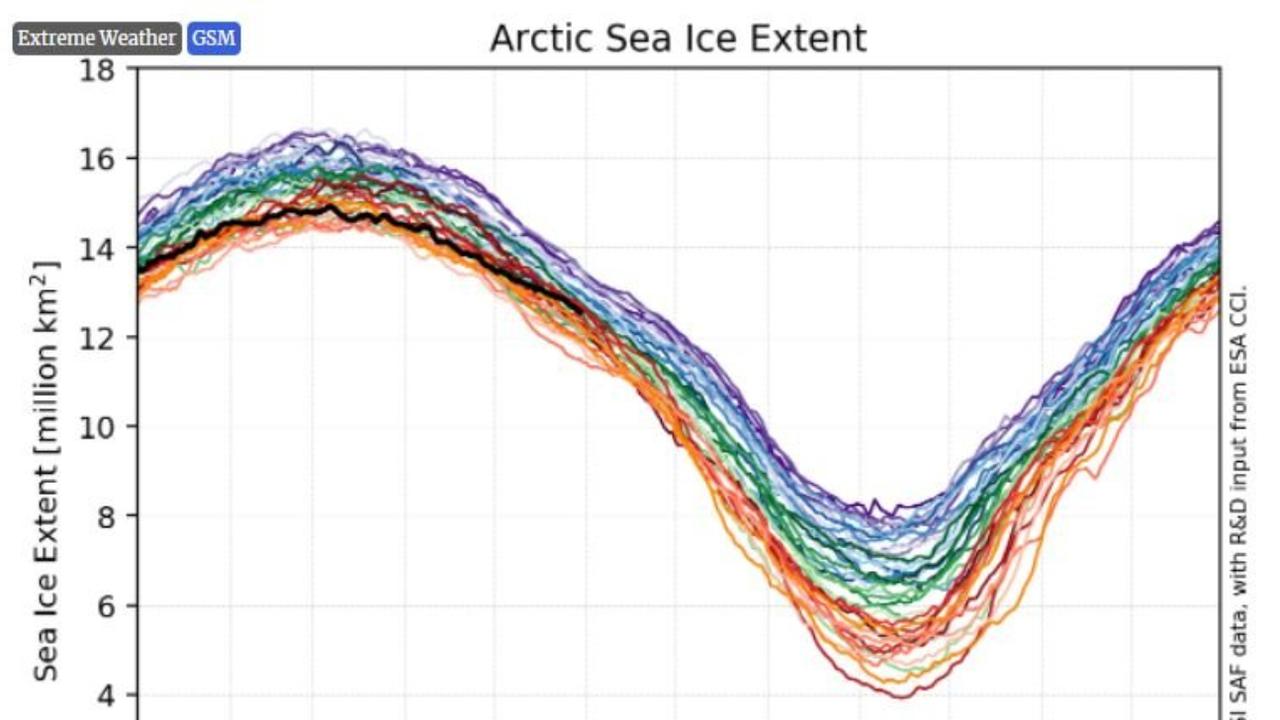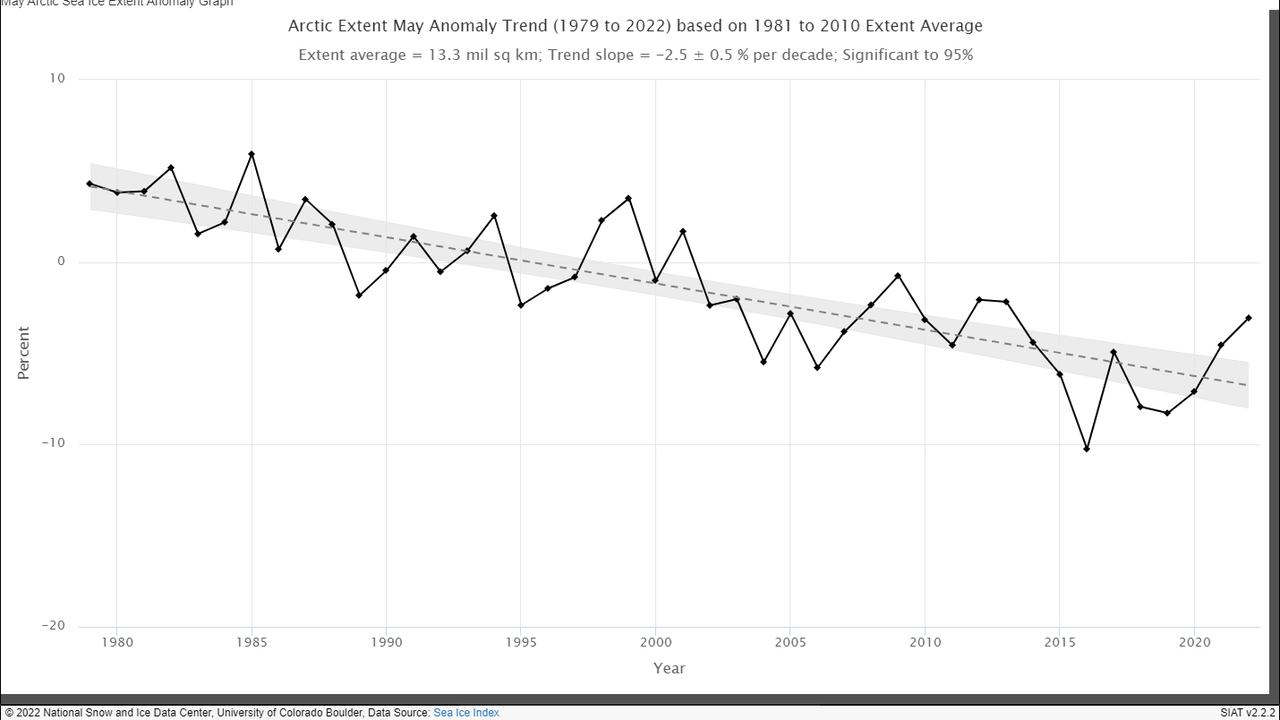WHAT WAS CLAIMED
The Arctic sea ice extent is at a 30-year high.
OUR VERDICT
False. The Arctic sea ice extent has been greater at several points in recent years and data over 30 years shows a significant downward trend.
A post shared to a climate sceptics Facebook group claims that Arctic sea ice is at its greatest extent in 30 years, casting doubt over one of the strongest indicators of anthropogenic climate change.
However, the claim is false. Satellite data shows sea ice extent was greater at the same time of year on several occasions in recent decades. Additionally experts told AAP FactCheck there has been a clear trend of diminishing Arctic sea ice extent over three decades.
In a June 3 post (screenshot here), the Facebook user declares it is "bad news for the 'Arctic is melting' crowd," before stating "the latest data shows the Arctic sea ice extent is at a 30 year high".
Dr Walt Meier, senior research scientist at the National Snow and Ice Data Center (NSIDC), explained the sea ice extent is the amount of the ocean surface considered to be "ice-covered".
This figure is achieved by calculating the area of ocean in the Northern Hemisphere with a sea ice concentration (SIC) greater than 15 per cent, he told AAP FactCheck via email.
The post includes a graph (pictured below) alongside the 30-year high claim, with an N shaped bend giving the impression of a significant upward trend over recent years. However, the graph is crucially missing its x-axis, indicating that the time period for the data is the months of the year.

The graph can be seen in its original form here. The lines in the graph represent each year's sea ice extent since 1980 with the extent for 2022 represented by the thick black line. It is clearly visible within the range for ice extent since 2010 and lower than the extent in the 1980s and 1990s.
This interactive tool (archived here) on the NSIDC website shows that ice extent is lower currently (June 8, 2022) as well as when the claim was made (June 3, 2022) than it was at the same time in 2013 and 2012, which ended up being the lowest year for Arctic sea ice extent on record.
This is confirmed in the monthly data figures available here. Sea ice extent for May 2022, the most recent month of data available, was 12.88 million sq km, while in May 2013 it was 13 million sq km. It has been lower several times for the month of May in the last few decades.
In fact, 2004 is the earliest year on record with a lower sea ice extent in May than 2022.
Dr Isobel Lawrence, an earth observation scientist at the University of Leeds, said the best way to ascertain sea ice extent is to compare it to full time-series data for that month, rather than comparing one specific point in time to another point in time.
The sea ice extent anomaly (difference) for the month of May is shown in this graph.

"You can see an overall downward trend (-2.6% per decade), but also lots of year-to-year variability," Dr Lawrence explained in an email.
"People love to highlight this variability and argue e.g. that 'sea ice this month was higher than the same month in 2004', which from the plot is true, but there is always lots of variability because of how sensitive sea ice is to variability in the climate system.
"There will always be years when natural variability of the climate system enhances or dampens the overall trend."
Dr Will Hobbs, a physical oceanographer and sea ice project co-lead for the Australian Antarctic Program Partnership (AAPP), told AAP FactCheck there were a number of factors behind variability.
"The simple answer is weather," he said via email. "Sea ice is affected by the ocean and the atmosphere, most interannual variability is explained by the atmosphere, which moves ice around through wind, and obviously also affects the surface temperature."
Dr Meier said modes of climate variability that occur over several years, such as the Arctic Oscillation, are also responsible.
"It is a kind of polar 'El Nino, La Nina' cycle where conditions can vary over multi-years," he explained.
Dr Meier likened this variability to the changing of the seasons.
"We don't see every day slightly warmer as we go from winter to summer. The sun is rising higher through that period, slowly adding energy so that summer is much warmer than winter, but during the transition there can be relatively warm or relatively cold periods due to weather."
He added: "Warming in the Arctic due to greenhouse gas emission is a small but relentless factor that is always pushing the system toward warmer temperatures and less ice. But it is slow and acts over decades. Over shorter periods, other things can be a bigger factor. So that is why we see ups and down."
Dr Lawrence said the longer-term picture is clear with an all-month trend of about four per cent reduction per decade. In September, when sea ice is at its minimum, the trend is a more than 10 per cent per decade, she added.
Professor Ian Simmonds, professorial fellow at University of Melbourne's School of Geography, Earth and Atmospheric Sciences, said the trend for the Southern Hemisphere, made for equally grim reading.
"The authors and contributors to the post have studiously avoided what is happening in the 'other' polar region. The Antarctic plot (archived June 8, 2022) shows that this year is tracking very low, with a new record low recorded in February, and January and March exhibited their second lowest sea ice extent on record."
The Verdict
The claim that Arctic sea ice extent is at the highest level in 30 years is false. The most recent monthly extent has been higher at several points over recent years. Experts said despite interannual variability, Arctic sea ice extent has been trending consistently downwards over the past 30 years.
False – The claim is inaccurate.
AAP FactCheck is an accredited member of the International Fact-Checking Network. To keep up with our latest fact checks, follow us on Facebook, Twitter and Instagram.












